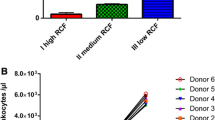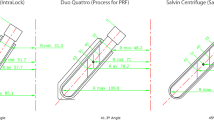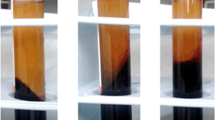Abstract
Platelet rich fibrin (PRF) is a blood concentrate system obtained by centrifugation of peripheral blood. First PRF matrices exhibited solid fibrin scaffold, more recently liquid PRF-based matrix was developed by reducing the relative centrifugation force and time. The aim of this study was to systematically evaluate the influence of RCF (relative centrifugal force) on cell types and growth factor release within injectable PRF- in the range of 60–966 g using consistent centrifugation time. Numbers of cells was analyzed using automated cell counting (platelets, leukocytes, neutrophils, lymphocytes and monocytes) and histomorphometrically (CD 61, CD- 45, CD-15+, CD-68+, CD-3+ and CD-20). ELISA was utilized to quantify the concentration of growth factors and cytokines including PDGF-BB, TGF-β1, EGF, VEGF and MMP-9. Leukocytes, neutrophils, monocytes and lymphocytes had significantly higher total cell numbers using lower RCF. Whereas, platelets in the low and medium RCF ranges both demonstrated significantly higher values when compared to the high RCF group. Histomorphometrical analysis showed a significantly high number of CD61+, CD-45+ and CD-15+ cells in the low RCF group whereas CD-68+, CD-3+ and CD-20+ demonstrated no statistically significant differences between all groups. Total growth factor release of PDGF-BB, TGF-β1 and EGF had similar values using low and medium RCF, which were both significantly higher than those in the high RCF group. VEGF and MMP-9 were significantly higher in the low RCF group compared to high RCF. These findings support the LSCC (low speed centrifugation concept), which confirms that improved PRF-based matrices may be generated through RCF reduction. The enhanced regenerative potential of PRF-based matrices makes them a potential source to serve as a natural drug delivery system. However, further pre-clinical and clinical studies are required to evaluate the regeneration capacity of this system.
Graphical abstract






Similar content being viewed by others
References
Choukroun J, Adda F, Schoeffler C, Vervelle A. Une opportunité en paro-implantologie: le PRF. Implantodontie 2001;42:55–62
Ghanaati S, Booms P, Orlowska A, Kubesch A, Lorenz J, Rutkowski J, Landes C, Sader R, Kirkpatrick C, Choukroun J. Advanced Platelet-Rich Fibrin: A New Concept for Cell-Based Tissue Engineering by Means of Inflammatory Cells. J Oral Implantol 2014;40:679–89. https://doi.org/10.1563/aaid-joi-D-14-00138
Miron RJ, Fujioka-Kobayashi M, Bishara M, Zhang Y, Hernandez M, Choukroun J. Platelet-Rich Fibrin and Soft Tissue Wound Healing: A Systematic Review. Tissue Eng Part B Rev 2017;23:83–99. https://doi.org/10.1089/ten.TEB.2016.0233
Jenne CN, Urrutia R, Kubes P. Platelets: bridging hemostasis, inflammation, and immunity. Int J Lab Hematol 2013;35:254–61. https://doi.org/10.1111/ijlh.12084
Schmidt-Bleek K, Kwee BJ, Mooney DJ, Duda GN. Boon and Bane of Inflammation in Bone Tissue Regeneration and Its Link with Angiogenesis. Tissue Eng Part B Rev 2015;21:354–64. https://doi.org/10.1089/ten.TEB.2014.0677
Clark Ra. Fibrin and wound healing. Ann N Y Acad Sci 2001;936:355–67. https://doi.org/10.1111/j.1749-6632.2001.tb03522.x
Sahni A, Francis CW. Vascular endothelial growth factor binds to fibrinogen and fibrin and stimulates endothelial cell proliferation. Blood 2000;96:3772–78.
El Bagdadi K, Kubesch A, Yu X, Al-Maawi S, Orlowska A, Dias A, Booms P, Dohle E, Sader R, Kirkpatrick CJ, Choukroun J, Ghanaati S. Reduction of relative centrifugal forces increases growth factor release within solid platelet-rich-fibrin (PRF)-based matrices: a proof of concept of LSCC (low speed centrifugation concept), Eur. J Trauma Emerg Surg. 2017. https://doi.org/10.1007/s00068-017-0785-7
Miron RJ, Fujioka-Kobayashi M, Hernandez M, Kandalam U, Zhang Y, Ghanaati S, Choukroun J. Injectable platelet rich fibrin (i-PRF): opportunities in regenerative dentistry? Clin Oral Investig 2017. https://doi.org/10.1007/s00784-017-2063-9
Choukroun J, Ghanaati S. Reduction of relative centrifugation force within injectable platelet-rich-fibrin (PRF) concentrates advances patients’ own inflammatory cells, platelets and growth factors: the first introduction to the low speed centrifugation concept. Eur J Trauma Emerg Surg 2017. https://doi.org/10.1007/s00068-017-0767-9
Ghanaati S, Orth C, Unger RE, Barbeck M, Webber MJ, Motta A, Migliaresi C. C. James Kirkpatrick, Fine-tuning scaffolds for tissue regeneration: effects of formic acid processing on tissue reaction to silk fibroin. J Tissue Eng Regen Med 2010;4:464–72. https://doi.org/10.1002/term.257
Barbeck M, Lorenz J, Kubesch A, Böhm N, Booms P, Choukroun J, Sader R, Kirkpatrick CJ, Ghanaati S. Porcine Dermis-Derived Collagen Membranes Induce Implantation Bed Vascularization Via Multinucleated Giant Cells: A Physiological Reaction? J Oral Implantol 2015;41:e238–e51. https://doi.org/10.1563/aaid-joi-D-14-00274
Barbeck M, Motta A, Migliaresi C, Sader R, Kirkpatrick CJ, Ghanaati S. Heterogeneity of biomaterial-induced multinucleated giant cells: Possible importance for the regeneration process? J Biomed Mater Res—Part A. 2016;104:413–18. https://doi.org/10.1002/jbm.a.35579
Barbeck M, Unger RE, Booms P, Dohle E, Sader RA, Kirkpatrick CJ, Ghanaati S, Monocyte preseeding leads to an increased implant bed vascularization of biphasic calcium phosphate bone substitutes via vessel maturation, J Biomed Mater Res—Part A 2016; 1–8. https://doi.org/10.1002/jbm.a.35834
Gurtner G, Werner S, Barrandon Y, Longaker M. Wound repair and regeneration. Nature 2008;453:314–21. https://doi.org/10.1038/nature07039
Nami N, Feci L, Napoliello L, Giordano A, Lorenzini S, Galeazzi M, Rubegni P, Fimiani M. Crosstalk between platelets and PBMC: New evidence in wound healing. Platelets 2016;27:143–8. https://doi.org/10.3109/09537104.2015.1048216
Nurden AT Platelets, inflammation and tissue regeneration, Thromb Haemost; 2011 S13-33. https://doi.org/10.1160/THS10-11-0720
Mcnally AK, Anderson JM. Phenotypic expression in human monocyte-derived interleukin-4-induced foreign body giant cells and macrophages in vitro: Dependence on material surface properties. J Biomed Mater Res A 2015;103(4):1380–90. https://doi.org/10.1002/jbm.a.35280
Vannella KM, Wynn TA. Mechanisms of Organ Injury and Repair by Macrophages. Annu Rev Physiol 2017;79:593–617. https://doi.org/10.1146/annurev-physiol-022516-034356.
Soloviev DA, Hazen SL, Szpak D, Bledzka KM, Ballantyne CM, Plow EF, Pluskota E. Dual Role of the Leukocyte Integrin M 2 in Angiogenesis. J Immunol 2014;193:4712–21. https://doi.org/10.4049/jimmunol.1400202
Ekström K, Omar O, Granéli C, Wang X, Vazirisani F, Thomsen P. Monocyte exosomes stimulate the osteogenic gene expression of mesenchymal stem cells. PLoS ONE 2013;8:e75227 https://doi.org/10.1371/journal.pone.0075227
Brinkmann V, Reichard U, Goosmann C, Fauler B, Uhlemann Y, Weiss DS, Weinrauch Y, Zychlinsky A. Neutrophil extracellular traps kill bacteria. Science 2004;303:1532–5. https://doi.org/10.1126/science.1092385
Mócsai A. Diverse novel functions of neutrophils in immunity, inflammation, and beyond. J Exp Med 2013;210:1283–99. https://doi.org/10.1084/jem.20122220
Pirraco RP, Reis RL, Marques AP. Effect of monocytes/macrophages on the early osteogenic differentiation of hBMSCs. J Tissue Eng Regen Med 2013;7:392–400. https://doi.org/10.1002/term.535
Omar OM, Granéli C, Ekström K, Karlsson C, Johansson A, Lausmaa J, Wexell CL, Thomsen P. The stimulation of an osteogenic response by classical monocyte activation. Biomaterials 2011;32:8190–204. https://doi.org/10.1016/j.biomaterials.2011.07.055
Grassi F, Cattini L, Gambari L, Manferdini C, Piacentini A, Gabusi E, Facchini A, Lisignoli G. T cell subsets differently regulate osteogenic differentiation of human mesenchymal stromal cells in vitro. J Tissue Eng Regen Med 2016;10:305–14. https://doi.org/10.1002/term.1727
Croes M, Cumhur Öner F, van Neerven D, Sabir E, Kruyt MC, Blokhuis TJ, Dhert WJ, Alblas J. Proinflammatory T cells and IL-17 stimulate osteoblast differentiation. Bone 2016;84:262–70. https://doi.org/10.1016/j.bone.2016.01.010
Kim B-C, Kim HT, Park SH, Cha J-S, Yufit T, Kim S-J, Falanga V. Fibroblasts from chronic wounds show altered TGF-?-signaling and decreased TGF-? Type II Receptor expression. J Cell Physiol 2003;195:331–336. https://doi.org/10.1002/jcp.10301
Digiovanni CW, Petricek JM. The Evolution of rhPDGF-BB in Musculoskeletal Repair and its Role in Foot and Ankle Fusion Surgery. Foot Ankle Clin NA. 2010;15:621–640. https://doi.org/10.1016/j.fcl.2010.07.001
Lichtman MK, Otero-Vinas M, Falanga V. Transforming growth factor beta (TGF-β) isoforms in wound healing and fibrosis. Wound Repair Regen 2016;24:215–22. https://doi.org/10.1111/wrr.12398
Roberts AB, Sporn MB, Assoian RK, Smith JM, Roche NS, Wakefield LM, Heine UI, Liotta LA, Falanga V, Kehrl JH. Transforming growth factor type beta: rapid induction of fibrosis and angiogenesis in vivo and stimulation of collagen formation in vitro. Proc Natl Acad Sci U S A 1986;83:4167–71. http://www.ncbi.nlm.nih.gov/pubmed/2424019 accessed August 19, 2016
Alexander PB, Yuan L, Yang P, Sun T, Chen R, Xiang H, Chen J, Wu H, Radiloff DR, Wang X-F. EGF promotes mammalian cell growth by suppressing cellular senescence. Cell Res 2015;25:135–38. https://doi.org/10.1038/cr.2014.141
Seeger MA, Paller AS. The Roles of Growth Factors in Keratinocyte Migration. Adv Wound Care 2015;4:213–24. https://doi.org/10.1089/wound.2014.0540
Forsberg S, Rollman O. Re-epithelialization from human skin explant cultures is promoted by ligand-activated HER3 receptor. J Dermatol Sci 2010;59:7–15. https://doi.org/10.1016/j.jdermsci.2010.03.017
Moens S, Goveia J, Stapor PC, Cantelmo AR, Carmeliet P. The multifaceted activity of VEGF in angiogenesis – Implications for therapy responses. Cytokine Growth Factor Rev 2014;25:473–82. https://doi.org/10.1016/j.cytogfr.2014.07.009
Koch S, Claesson-Welsh L. Signal Transduction by Vascular Endothelial Growth Factor Receptors, Cold Spring Harb. Perspect Med 2012;2:a006502–a006502. https://doi.org/10.1101/cshperspect.a006502
Carmeliet P, Jain RK. Molecular mechanisms and clinical applications of angiogenesis. Nature 2011;473(7347):298–307. https://doi.org/10.1038/nature10144
Heissig B, Nishida C, Tashiro Y, Sato Y, Ishihara M, Ohki M, Gritli I, Rosenkvist J, Hattori K. Role of neutrophil-derived matrix metalloproteinase-9 in tissue regeneration. Histol Histopathol 2010;25:765–70. http://www.ncbi.nlm.nih.gov/pubmed/20376783 accessed September 11, 2016
Acknowledgements
The authors would like to thank Mrs. Verena Hoffmann for her excellent technical assistance. This work was partially funded by Marie Curie Actions under EU FP7 Initial Training Network SNAL 608184.
Author information
Authors and Affiliations
Corresponding author
Ethics declarations
Conflict of interest
The authors declare that they have no competing interests. Joseph Choukroun is the owner of PROCESS. None of the present protocols have been approved yet for clinical application.
Rights and permissions
About this article
Cite this article
Wend, S., Kubesch, A., Orlowska, A. et al. Reduction of the relative centrifugal force influences cell number and growth factor release within injectable PRF-based matrices. J Mater Sci: Mater Med 28, 188 (2017). https://doi.org/10.1007/s10856-017-5992-6
Received:
Accepted:
Published:
DOI: https://doi.org/10.1007/s10856-017-5992-6




